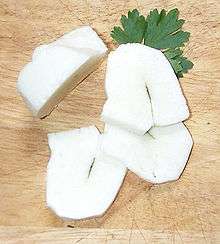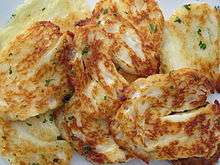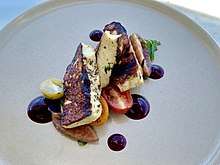Halloumi
Halloumi or haloumi (/həˈluːmi/) is a semi-hard, unripened, brined cheese made from a mixture of goat's and sheep's milk, and sometimes also cow's milk.[4][5][6][7] It has a high melting point and so can easily be fried or grilled. This property makes it a popular meat substitute. Rennet is used to curdle the milk in halloumi production,[8] although no acid-producing bacteria are used in its preparation.[9]
| Halloumi | |
|---|---|
 Fresh sliced halloumi | |
| Country of origin | Eastern Mediterranean[1][2][3] |
| Source of milk | Goat, sheep, sometimes cow |
| Pasteurised | Commercially, but not traditionally |
| Texture | Semi-soft |
| Aging time | Commercially not aged Traditionally aged |
| Certification | No |
Halloumi is often associated with the island of Cyprus, where it has been produced by a multi-ethnic population for many centuries.[1] It is also popular throughout the region broadly known as the Levant.[10][11] It became widely available in Turkey after 2000.[1] By 2013, demand in the United Kingdom had surpassed that in every other European country except Cyprus.[12]
Etymology
The English name halloumi is derived from Modern Greek: χαλλούμι [xaˈlumi], khalloúmi, from Cypriot Maronite Arabic xallúm,[13][14] ultimately from Egyptian Arabic: حلوم ḥallūm [ħalˈluːm].[13][14][15] The Egyptian Arabic word is itself a loanword from Coptic ϩⲁⲗⲱⲙ halōm (Sahidic) and ⲁⲗⲱⲙ alōm (Bohairic), and was used for cheese eaten in medieval Egypt.[16][17][18] The name of the cheese likely goes back the Demotic word ḥlm "cheese" attested in manuscripts and ostraca from 2nd century Roman Egypt.[19]
The Cypriot Turkish name hellim and the name of the modern Egyptian cheese hâlûmi both derive from this source, though the latter is essentially a different cheese from the Cypriot one.[17]
History

The methods of making halloumi and cheeses such as feta likely originated sometime in the Medieval Byzantine period (AD 395 – 1191).[20] A recipe for enhancing ḥālūm ('cheese') by brining is found in the 14th-century Egyptian cookbook Kanz al-Fawāʾid fī Tanwīʿ al-Mawāʾid.[21]
The earliest known surviving descriptions of Cypriot halloumi were recorded in the mid-16th century by Italian visitors to Cyprus,[22][3] where it is often said to have originated.[10] However, the question of whether the recipe for the quintessential halloumi was born in Cyprus and then travelled to Lebanon and the rest of the Levant, or whether the basic techniques of making cheese that resists melting evolved over time in various parts of the eastern Mediterranean—or both—does not have a definitive answer.[1][2][3]
Cypriot farmers relied on halloumi as a source of protein and in many villages the entire community would join forces and make huge batches together. Recipes varied from village to village, with each taking great pride in their special technique and secret ingredients. Halloumi became so important to village life that even the surnames of many Cypriot families reflect their role in halloumi production, with names such as Hallumas, Halluma and Hallumakis common by the 19th century.
Traditionally, halloumi was made from sheep and goat milk, since there were few cows on the island until they were brought over by the British in the 20th century. But as demand grew, industrial cheese-makers began using more of the cheaper and more plentiful cow's milk.[23]
Halloumi is registered as a protected Cypriot product within the United States (since the 1990s) but not yet in the European Union. The delay in registering the name halloumi with the EU has been largely due to a conflict between dairy producers and sheep and goat farmers as to whether registered halloumi may contain cow's milk, and how much.[24][25] In the UK, halloumi is a trademark of Cyprus.[26]
Overview and preparation

The cheese is white, with a distinctive layered texture, similar to mozzarella, and has a salty flavour. It is stored in its natural juices. It is commonly garnished with mint, a practice based on the fact that halloumi keeps better and stays fresher and more flavoursome when wrapped with mint leaves. In accordance with this tradition, some packages of halloumi contain fragments of mint leaves on the surface of the cheese.
The cheese is often used in cooking and can be fried until brown without melting, owing to its higher-than-normal melting point. This makes it an excellent cheese for frying or grilling (as in saganaki) or fried and served with vegetables, or as an ingredient in salads. Cypriots like eating halloumi with watermelon in the warm months, and as halloumi and lountza, a combination of halloumi cheese and either a slice of smoked pork, or a soft lamb sausage. In many regions it is often eaten with breakfast, or as a light meal or side dish.
The resistance to melting comes from the fresh curd being heated before being shaped and placed in brine.[27] Traditional halloumi is a semicircular shape, about the size of a large wallet, weighing 220–270 grams (7.8–9.5 oz). The fat content is approximately 25% wet weight, 47% dry weight with about 17% protein. Its firm texture when cooked causes it to squeak on the teeth when being chewed.[28]
Traditional halloumi is made from unpasteurised sheep and goat milk. Many people also like halloumi that has been aged; kept in its brine, it is much drier, much stronger and much saltier, making it very different from the milder halloumi generally used in the West.
Nutritional facts
100 grams of commercially produced packaged halloumi has a typical composition of:[29]
| Fat | 26.9 g |
|---|---|
| Carbohydrate | 2.2 g |
| Protein | 21.2 g |
| Energy | 336 kcal |
| Salt | 2.8 g |
See also
- Fried cheese
- Leipäjuusto
- List of cheeses – list of cheeses by place of origin
- Queijo coalho
- Saganaki
References
- Welz, Gisela (1 September 2015). European Products: Making and Unmaking Heritage in Cyprus. Berghahn Books. pp. 93–110. ISBN 9781782388234 – via Google Books.
- Garanti, Zanete (April 2016). "Marketing Hellim / Halloumi Cheese: A Comparative Study of Northern and Southern Cyprus" (PDF). Proceedings of the 2016 International Conference "Economic Science for Rural Development" No 43. pp. 134–142. Retrieved 25 October 2018.
- P. Papademas, "Halloumi Cheese", p. 117ff, in Adnan Tamime, ed., Brined Cheeses in the Society of Dairy Technology series, Blackwell 2006, ISBN 1-4051-2460-1
- Gibbs, Paul; Morphitou, Ria; Savva, George (2004). "Halloumi: exporting to retain traditional food products". British Food Journal. 106 (7): 569–576. doi:10.1108/00070700410545755.
- "Cyprus - Cultural life - Daily life and social customs - halloumi cheese". www.britannica.com. Retrieved 16 June 2009.
Geography has left Cyprus heir to numerous culinary traditions—particularly those of the Levant, Anatolia, and Greece — but some dishes, such as the island’s halloumi cheese…are purely Cypriot
- Ayto, John (1990). The glutton's glossary: a dictionary of food and drink terms. Routledge. p. 133. ISBN 0-415-02647-4.
Haloumi, or halumi, is a mild salty Cypriot cheese made from goat's, ewe's, or cow's milk.
- Dew, Philip – Reuvid, Jonathan - Consultant Editors (2005). Doing Business with the Republic of Cyprus. GMB Publishing Ltd. p. 46. ISBN 1-905050-54-2.
Cyprus has managed to secure EU recognition of halloumi as a traditional cheese of Cyprus ; therefore no other country may export cheese of the same name
CS1 maint: multiple names: authors list (link) - Lazarou, Stalo. "Χαλλούμι". foodmuseum.cs.ucy.ac.cy (in Greek). Cyprus Food Virtual Museum. Retrieved 30 November 2015.
- Charles O'Connor. Traditional Cheesemaking Manual. International Livestock Centre for Africa.
- Robinson, R. K. – Tamime, A. Y. (1991). Feta and Related Cheeses. Woodhead Publishing. p. 144. ISBN 1-85573-278-5.
Halloumi is a semi-hard to hard, unripened cheese that, traditionally, is made from either sheep's milk or goat's milk or a mixture of the two. Although the cheese has its origins in Cyprus, it is widely popular throughout the Middle East, and hence many countries have now become involved with its manufacture. In Australia, it is coated with a greek yogurt
CS1 maint: multiple names: authors list (link) - Allen, Gary J. (2007). The herbalist in the kitchen. University of Illinois Press. p. 212. ISBN 978-0-252-03162-5.
Haloumi (sometimes spelled Halloumi) is a brine-cured cheese from Cyprus containing chopped mint.
- Cooke, Nicholas (22 September 2013). "How halloumi took over the UK". BBC News. Retrieved 23 September 2013.
- Company, Houghton Mifflin Harcourt Publishing. "The American Heritage Dictionary entry: halloumi". ahdictionary.com. Retrieved 25 October 2018.
- Borg, Alexander (2004). A Comparative Glossary of Cypriot Maronite Arabic (Arabic-English): With an Introductory Essay. Brill. pp. 11, 209–210. ISBN 9789004131989 – via Google Books.
- "halloumi". Oxford English Dictionary (2nd ed.). Oxford University Press. 1989.
- Andriotis et al., Λεξικό της κοινής νεοελληνικής
- Otter, Don (25 October 2016). Donnelly, Catherine; Kehler, Mateo (eds.). The Oxford Companion to Cheese. Oxford University Press. ISBN 978-0-19-933089-8 – via Google Books.
- Davidson, Alan (21 August 2014). The Oxford Companion to Food. Oxford University Press. ISBN 978-0-19-104072-6 – via Google Books.
- Johnson, Janet. "Chicago Demotic Dictionary - Ḥ" (PDF). p. 246.
- Goldstein, Darra – Merkle, Kathrin – Parasecoli, Fabio – Mennell, Stephen - Council of Europe (2005). Culinary cultures of Europe: identity, diversity and dialogue. Council of Europe. p. 121. ISBN 92-871-5744-8.CS1 maint: multiple names: authors list (link)
- Nasrallah, Nawal (9 November 2017). Treasure Trove of Benefits and Variety at the Table: A Fourteenth-Century Egyptian Cookbook: English Translation, with an Introduction and Glossary. BRILL. ISBN 978-90-04-34991-9 – via Google Books.
- Patapiou, Nasa (2006). "Leonardo Donà in Cyprus - A future Doge in the Karpass Peninsula (1557)" (PDF). Cyprus Today. Press and Information Office, Ministry of Interior, Nicosia, Cyprus. p. 8. Retrieved 25 October 2018.
- In Cyprus, New Cheese Edict Gets the Goat of Dairy Farmers Wall Street Journal - October 11, 2012
- Application for the name ‘halloumi’ to go to EU in early 2007, Cyprus Mail archive article - Saturday, September 2, 2006 "Archived copy". Archived from the original on 30 September 2007. Retrieved 5 December 2006.CS1 maint: archived copy as title (link)
- Saoulli, Alexia (3 March 2007). "Halloumi bickering threatens EU application". Cyprus Mail. Archived from the original on 13 August 2007. Retrieved 4 March 2007.
- Financial Mirror, Editor. "Cyprus wins back UK halloumi trademark". Financial Mirror. Retrieved 14 February 2020.CS1 maint: extra text: authors list (link)
- Galarneau, Andrew Z (14 September 2008). "Elements: Halloumi -One ingredient, one dish". The Buffalo News. Retrieved 15 September 2008.
- Eskin, Leah (21 March 2016). "The salty, satisfying squeak of fried halloumi". NY Times. Retrieved 3 April 2017.
- "Tesco Halloumi 250G". Teso. Archived from the original on 14 April 2016. Retrieved 23 April 2016.
External links
| Look up halloumi in Wiktionary, the free dictionary. |
